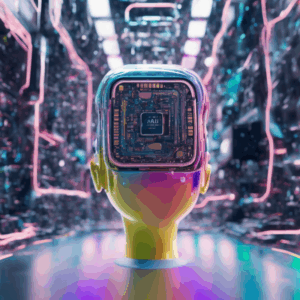
Should there be restrictions on the use of technology, such as AI-generated content and virtual reality, to protect individuals from immersive and potentially harmful digital experiences? As an authority on the subject, I can confidently say that this is a question that demands careful consideration. The advancement of technology has undoubtedly brought about numerous benefits, but it has also raised concerns about the potential risks associated with immersive digital experiences. In this blog post, we will explore the arguments for and against imposing restrictions on the use of technology to safeguard individuals from potential harm.
1. Preserving Mental Well-being:
One of the primary reasons for considering restrictions on technology is the potential impact on mental well-being. With the rise of AI-generated content and virtual reality, individuals are increasingly exposed to hyper-realistic and immersive experiences. While this can be entertaining and engaging, it also has the potential to blur the lines between reality and fiction, leading to confusion and psychological distress. Limiting the use of technology can help protect individuals from these adverse effects and ensure their mental well-being.
2. Preventing Addiction:
Another concern associated with immersive digital experiences is the risk of addiction. Technology, particularly virtual reality, has the ability to captivate users and create a sense of escape from the real world. This can be especially dangerous for individuals who are prone to addictive behaviors. By imposing restrictions on the use of technology, we can mitigate the potential for addiction and protect individuals from the detrimental consequences associated with excessive screen time.
3. Safeguarding Privacy:
AI-generated content has the ability to mimic human behavior and create highly realistic simulations. While this can be impressive from a technological standpoint, it also raises concerns about privacy and consent. If individuals are unaware that they are interacting with AI-generated content, their personal data and privacy may be compromised. Restricting the use of AI-generated content can help safeguard individuals’ privacy and ensure that their consent is obtained before their data is used.
4. Mitigating Physical Risks:
Virtual reality, in particular, poses physical risks to individuals. The immersive nature of VR experiences can lead to disorientation, dizziness, and even physical injuries if users are not careful. By imposing restrictions on VR usage, such as setting age limits or requiring supervision, we can minimize the potential for physical harm and ensure the safety of individuals engaging with this technology.
5. Balancing Innovation and Regulation:
While there are valid arguments for imposing restrictions on the use of AI-generated content and virtual reality, it is essential to strike a balance between innovation and regulation. Technology has the potential to revolutionize various industries and enhance our lives in countless ways. Overly restrictive measures may stifle innovation and limit the possibilities that technology can offer. It is crucial to find a middle ground that allows for exploration and growth while also protecting individuals from potential harm.
In conclusion, the question of whether there should be restrictions on the use of technology, such as AI-generated content and virtual reality, to protect individuals from immersive and potentially harmful digital experiences is a complex one. While there are valid concerns about mental well-being, addiction, privacy, and physical risks, it is also important to consider the potential for innovation and growth. Striking a balance between regulation and innovation is key to ensuring that technology benefits society without compromising individual well-being. So, the answer lies in finding a thoughtful and nuanced approach that safeguards individuals while still allowing for the advancement and exploration of technology.
The Rise of AI Generated Content: Unveiling the Hidden Dangers Lurking Within
“The Rise of AI Generated Content: Unveiling the Hidden Dangers Lurking Within”
1. Introduction
– The increasing use of technology, particularly AI-generated content and virtual reality, has raised concerns about potential harms and the need for restrictions to protect individuals.
– This article aims to explore the hidden dangers associated with AI-generated content and virtual reality experiences, highlighting the potential risks and the importance of implementing restrictions.
2. Ethical Concerns Surrounding AI-generated Content
– AI-generated content has the ability to produce realistic and believable text, images, videos, and audio, blurring the line between real and artificial.
– This raises ethical concerns as individuals may be exposed to misleading or false information, maliciously created content, or even deepfakes that can be used to manipulate or deceive people.
3. Psychological Implications of Immersive Digital Experiences
– Immersive digital experiences, such as virtual reality, have the potential to deeply impact individuals psychologically.
– Prolonged exposure to these experiences can lead to desensitization, addiction, and detachment from reality, posing a risk to mental health and social well-being.
4. Manipulation and Influence
– AI-generated content can be used to manipulate and influence individuals in various ways.
– This includes targeted advertising, political propaganda, and even personalized fake news, which can sway public opinion, manipulate decision-making processes, and undermine democracy.
5. Privacy and Data Security Concerns
– The use of AI-generated content and virtual reality involves the collection and analysis of vast amounts of personal data.
– This raises concerns about privacy and data security, as individuals may unknowingly share sensitive information that can be exploited by malicious actors.
6. Potential Legal Issues
– The emergence of AI-generated content and virtual reality challenges existing legal frameworks.
– Determining liability for harmful content, regulating the use of AI-generated content for commercial purposes, and protecting intellectual property rights are just a few of the legal issues that need to be addressed.
7. The Need for Restrictions and Regulations
– To protect individuals from the potential dangers of AI-generated content and virtual reality, it is crucial to implement restrictions and regulations.
– This can include ensuring transparency in AI systems, establishing guidelines for responsible use, and enforcing penalties for misuse or harm caused by AI-generated content.
8. Balancing Innovation and Safety
– While restrictions are necessary, it is important to strike a balance between innovation and safety.
– Encouraging responsible development and usage of AI-generated content and virtual reality can foster creativity and progress while minimizing the potential risks.
In conclusion, the rise of AI-generated content and virtual reality brings with it hidden dangers that require careful consideration. Ethical concerns, psychological implications, manipulation and influence, privacy and data security concerns, potential legal issues, and the need for restrictions and regulations are all critical aspects that must be addressed. By striking a balance between innovation and safety, society can benefit from the advancements in technology while minimizing the potential harms.
The Power Duo: Unveiling the Unmatched Advantages of AI and VR in Revolutionizing Industries
The Power Duo: Unveiling the Unmatched Advantages of AI and VR in Revolutionizing Industries
1. Introduction: The World of AI and VR
In today’s rapidly evolving technological landscape, Artificial Intelligence (AI) and Virtual Reality (VR) have emerged as two powerful forces poised to revolutionize industries across the board. AI, with its ability to process vast amounts of data and make intelligent decisions, and VR, with its immersive and interactive experiences, have the potential to transform the way we live, work, and play. However, as with any powerful tool, there are concerns about the potential risks and harmful effects they may have on individuals. Should there be restrictions on the use of AI-generated content and VR to protect individuals from immersive and potentially harmful digital experiences? Let’s delve deeper into this question.
2. Balancing Innovation and Safety
While it is crucial to embrace technological advancements and harness their full potential, it is equally important to ensure the safety and well-being of individuals. Restrictions on the use of AI-generated content and VR can play a vital role in striking this balance. By imposing regulations and guidelines, policymakers can address concerns such as data privacy, content reliability, and user safety. For instance, strict regulations can prohibit the creation and dissemination of AI-generated content that promotes hate speech, misinformation, or harmful behavior. Similarly, guidelines can be put in place to ensure VR experiences are designed with safety measures, such as motion sickness prevention and appropriate content warnings.
3. Protecting Vulnerable Individuals
One of the primary reasons for imposing restrictions on the use of AI-generated content and VR is to protect vulnerable individuals from potential harm. Children, for example, are particularly susceptible to the influence of technology and may not have the cognitive ability to distinguish between virtual and real-world experiences. Restrictions can help safeguard their psychological well-being by ensuring that AI-generated content and VR experiences are age-appropriate and do not expose them to explicit or harmful content. Moreover, individuals with pre-existing mental health conditions, such as anxiety or phobias, may be negatively affected by certain VR experiences. Imposing restrictions can help prevent triggering or exacerbating these conditions, promoting a safer and more inclusive technological landscape.
4. Striking a Balance: Education and Awareness
While restrictions can provide necessary safeguards, it is also essential to foster education and awareness about AI and VR. By promoting digital literacy and responsible use of technology, individuals can make informed choices and navigate the digital world more safely. This can be achieved through educational campaigns, workshops, and collaborations between technology companies, educators, and policymakers. Additionally, robust labeling and rating systems can help users identify trustworthy AI-generated content and make informed decisions about the VR experiences they engage with.
5. Conclusion: Harnessing the Power Duo Responsibly
In conclusion, the unmatched advantages of AI and VR in revolutionizing industries are undeniable. However, it is crucial to strike a balance between innovation and safety. Restrictions on the use of AI-generated content and VR can protect individuals from immersive and potentially harmful digital experiences, particularly vulnerable populations. By combining regulations with education and awareness initiatives, we can foster a responsible and inclusive technological landscape that maximizes the benefits of AI and VR while minimizing potential risks. So, let’s unleash the power duo of AI and VR while ensuring the well-being of individuals in the digital age.
Choosing the Perfect Device: Unveiling the Ideal Platform for Augmented Reality Experiences
Choosing the perfect device for augmented reality (AR) experiences is crucial in ensuring an immersive and enjoyable digital journey. With the advancements in technology, particularly in AI-generated content and virtual reality (VR), it is important to consider whether there should be restrictions to protect individuals from potentially harmful digital experiences. In this article, we will explore the key factors to consider when choosing a device for AR and discuss the need for restrictions in the use of technology.
1. Device Compatibility:
– The first step in choosing the perfect device for AR experiences is to ensure compatibility. Look for devices that are specifically designed for AR applications, such as smartphones with AR capabilities or dedicated AR headsets. These devices are equipped with the necessary sensors and processing power to provide a seamless AR experience.
2. Display Quality:
– The quality of the display plays a significant role in the overall AR experience. Look for devices with high-resolution displays and good color accuracy to ensure realistic and vibrant visuals. Additionally, devices with a high refresh rate can provide smoother animations and reduce motion sickness, making the experience more enjoyable.
3. Processing Power:
– AR applications require significant processing power to render 3D objects in real-time. Choose devices with powerful processors and sufficient RAM to handle complex AR content without lag or frame drops. This will ensure a smooth and responsive AR experience.
4. Tracking Capabilities:
– Accurate tracking is essential for a seamless AR experience. Look for devices with advanced tracking technologies, such as simultaneous localization and mapping (SLAM) or inside-out tracking. These technologies enable the device to accurately track the user’s movements and position virtual objects in the real world.
5. User Interface:
– A user-friendly interface is crucial for an immersive AR experience. Consider devices that provide intuitive controls and easy navigation. Some devices even offer gesture-based controls or voice commands, enhancing the overall user experience.
Now, let’s address the question of whether there should be restrictions on the use of technology to protect individuals from potentially harmful digital experiences. While AR and VR technologies offer exciting possibilities, it is important to ensure user safety and well-being. Restrictions can be implemented to prevent the creation or distribution of content that may cause harm or discomfort to individuals. These restrictions can include guidelines for content creators, age restrictions for certain types of content, and measures to prevent the misuse of personal data.
However, it is important to strike a balance between protecting individuals and allowing for innovation and creativity in the digital realm. The development of AI-generated content and VR experiences has the potential to revolutionize various industries, including education, entertainment, and healthcare. By implementing responsible use and ethical guidelines, we can harness the power of these technologies while safeguarding individuals from potential harm.
In conclusion, choosing the perfect device for AR experiences involves considering factors such as compatibility, display quality, processing power, tracking capabilities, and user interface. While there should be restrictions in place to protect individuals from potentially harmful digital experiences, it is important to find a balance that allows for innovation and creativity. By doing so, we can unlock the full potential of AI-generated content and VR while ensuring the safety and well-being of users.
Should there be restrictions on the use of technology, such as AI-generated content and virtual reality, to protect individuals from immersive and potentially harmful digital experiences?
**What are the potential risks of immersive technology?**
One of the main concerns surrounding the use of immersive technology, such as AI-generated content and virtual reality, is the potential harm it can cause to individuals. As these technologies become more advanced and realistic, there is a risk that users may become too immersed in the digital world, leading to a disconnect from reality. This can have negative consequences on mental health, as individuals may struggle to differentiate between what is real and what is virtual. Additionally, there is a concern that these technologies can be used to manipulate or deceive individuals, leading to further harm.
**Should there be restrictions on the use of AI-generated content?**
The use of AI-generated content raises ethical questions about the authenticity and reliability of information. With AI algorithms capable of creating realistic and convincing content, there is a risk of spreading misinformation or propaganda. Should there be restrictions in place to ensure that AI-generated content is clearly labeled and regulated? This would help protect individuals from being deceived or manipulated by false information.
**What about virtual reality?**
Virtual reality (VR) is a rapidly advancing technology that offers immersive experiences in a virtual world. While VR has many potential benefits, such as its use in healthcare or education, there are also risks associated with its use. Extended exposure to VR can lead to motion sickness, eye strain, and disorientation. There is also a concern that individuals may become addicted to the virtual world, neglecting real-life responsibilities and relationships. Should there be restrictions on the use of VR to prevent these potential harms?
**Conclusion**
In conclusion, there is a need for careful consideration when it comes to the use of technology such as AI-generated content and virtual reality. While these technologies have the potential to enhance our lives in many ways, there are also risks associated with their use. It is important to strike a balance between innovation and protection, ensuring that individuals are not exposed to harmful or deceptive digital experiences. By implementing clear regulations and guidelines, we can help safeguard individuals and promote responsible and ethical use of these technologies.









I believe restrictions are necessary to prevent potential harm from AI and VR.
AI and VR can enhance industries, but are we risking too much immersion? #debate
I think AI and VR should be regulated to prevent negative impacts. What do you guys think?
AI and VR can be amazing, but are we risking too much freedom with restrictions?
AI and VR can enhance but also harm. Should we regulate for balance?